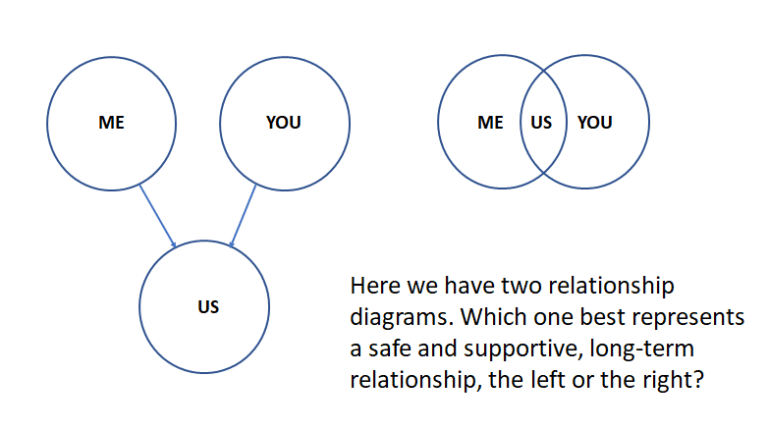
I’ts quiz time. I’ve talked about six stages of a long-term supportive relationship. Which one of these diagrams do you think represents the better relationship?
Many people have told me over the years that the right diagram is best. For them it represents togetherness, a true partnership, sharing everything. It does work, but really represents only the first stage in a relationship, the romantic stage. In my career I’ve only come across one couple where this may have worked over the long term, and it was unusual. The man and woman literally grew up next to each from the time they were toddlers, played together, and went through primary, middle and high school together. They had the same friends, interests, hobbies, activities, values, beliefs, knew each other’s secrets, and had many of the same habits and goals. The husband told me it was an ideal relationship.
People don’t grow up like this couple did. We all come from different backgrounds. We all have different beliefs, values, and histories. We also have different habits, secrets, goals, and baggage as well as different relational needs, expectations, and assumptions.
If you picked the right side I’m sorry. It won’t work long-term except in the movies, old TV shows, soap operas, and in fairy tales.
If my partner and I share everything in life one of us will inevitably start to feel smothered, the right side. One partner’s needs, wants, desires will inevitably smother those of their partner, and that’s not partnership where both people’s needs are being met. What happened to the couple I mentioned earlier? She died in a car accident. I met him several years later after he’d had four failed relationships. He’d tried to have the same type relationship he’d had with his wife and each time his partner-to-be rebelled. The ladies felt smothered, yet he couldn’t understand why.
The left side is the better choice. It shows two independent people sharing a relationship based on acceptance, mutual trust and respect, yet with boundaries (walls and doors, the lines connecting me-us, you-us) protecting the relationship from outside influences. Each has their own friends, interests, goals, secrets, habits, hobbies, etc. Each also has their own ideas of how a relationship should work, their own needs, expectations and assumptions about a relationship. And each has their own baggage to deal with. As a couple, however, there are common goals, common friends, interests, activities, hobbies, etc., and knowledge and acceptance of the baggage that each carries with them.

More knowledgeable folks than me say few couples will achieve a steady state of acceptance, the sixth stage of relationships. That’s what the left diagram represents. I agree, yet I also disagree.
Maintaining and staying (emphasis added) in the sixth stage this diagram represents is probably unrealistic – never (an absolute) arguing or disagreeing, always (another absolute) treating each other as adults, perfect (a third absolute) trust and respect. That doesn’t mean your relationship can’t look like and function like the left diagram for long periods. We can achieve it the majority of the time, but it takes consistent work to do so and conflicts / disagreements will occur.
The first step is to really know yourself. What do you need and expect from yourself and your partner? What are your assumptions about relationships? Are they realistic or unrealistic? Who do you feel is responsible for your happiness? Write them down, put them on paper, and then challenge them. If they’re unrealistic get rid of them. Stop judging If they aren’t your partner’s responsibility. The man I spoke about above was working off unrealistic expectations and assumptions, and he expected his partner to make him happy. The result for him was four failed relationships, and numerous people who’d been hurt by being in relationships with him.
These and other questions aren’t necessarily easy to answer but you need to have answers for yourself, really know yourself, if you want a strong, supportive relationship.
The most important aspect, to me, is that both parties needs, in and outside the relationship, are met on a regular basis. Both people need to know and support each other’s needs, and know and respect each other’s baggage. They really need to know each other, to be supportive of each other in a variety of ways, while still ensuring each person has the freedom to be independent. And that can set the stage for a strong, long-term relationship.
Want some help with your relationship or have some questions? Send me an email (info@thehavenplace.org) with your availability over the next week. I’ll get back to you within 24 hours with a day and time that works for both us.

